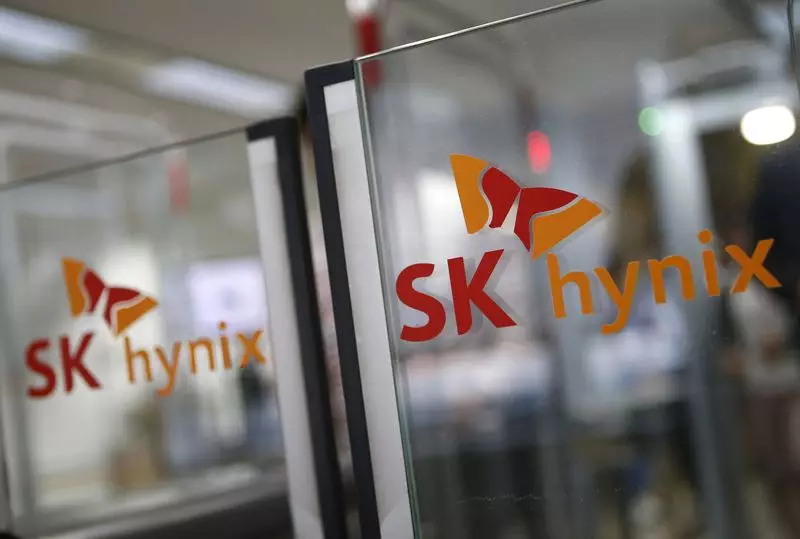In the competitive world of semiconductor manufacturing, South Korea’s SK Hynix stands out as a formidable player, particularly in the high-end segment that caters to generative artificial intelligence (AI). Recent reports suggest that the company anticipates a significant increase in sales for its advanced semiconductor products, predicting a doubling of sales within the year. This optimistic outlook comes on the heels of an unprecedented quarterly profit, which not only surpassed expectations but also outperformed that of its larger rival, Samsung. However, despite these positive indicators, SK Hynix’s stock experienced a decline, revealing the complexities of the memory market and the challenges looming on the horizon.
The semiconductor landscape is characterized by rapid innovation and fierce competition, particularly as demand for AI-driven technology surges. SK Hynix has positioned itself as a key supplier for major players like Nvidia, benefiting from the escalating need for high-performance chips. Nonetheless, the company has expressed caution regarding the overall memory chip market, predicting a pronounced decline in demand for commodity memory chips widely used in smartphones and computers. Economic uncertainties and rising competition from Chinese manufacturers present significant obstacles.
The Chief Financial Officer of SK Hynix, Kim Woo-hyun, aptly summarized the situation during an earnings call, acknowledging the contradictions that the market presents. On one hand, there’s a burgeoning demand for specialized high-bandwidth memory (HBM) chips, yet there’s a stark contrast in the demand trajectory for legacy products. Analysts note that trade protectionism and geopolitical tensions further compound these uncertainties, making the outlook increasingly precarious.
For the fourth quarter, SK Hynix reported an operating profit of approximately 8.1 trillion won ($5.64 billion), surpassing both prior expectations and Samsung’s results, which languished at around 6.5 trillion won. This triumph marks a significant milestone, indicating that SK Hynix has not only recovered from previous downturns but has also managed to capture market share from its competitors. The substantial growth in revenue—75% year-on-year—underlines the company’s effectiveness in navigating a challenging landscape.
Interestingly, a large proportion of SK Hynix’s revenue came from its HBM chips, which constituted 40% of the total DRAM revenue amid rising AI demands. This focus on high-margin products has allowed SK Hynix to excel while others falter, raising questions about the future competitive landscape. While the strong demand for AI chips is encouraging, analysts remain skeptical about the sustainability of this growth, especially when considering the anticipated slowdown in other semiconductor segments.
Despite its robust performance, SK Hynix faces a dual-edged sword in terms of investor sentiment. The company’s cautious forecast for first-quarter shipments did not meet expectations, as analysts predict a decline in DRAM and NAND flash memory chip shipments of 10% to 20%. This disappointment highlights the unpredictable nature of the semiconductor market, wherein even stellar past performances can lead to market corrections based on future outlooks.
Furthermore, SK Hynix’s capital expenditures for 2025 are expected to rise only marginally, reflecting a conservative approach amid growing concerns over demand fluctuations. Such a strategy may signal to investors that the company is bracing for potential headwinds, reinforcing the notion that volatility may become the norm rather than the exception in this high-stakes industry.
Looking ahead, SK Hynix remains optimistic about the AI industry’s potential to eclipse conventional market expectations and require substantial computing power, suggesting a robust long-term demand for HBM chips. The company has already initiated talks regarding supply agreements for 2026 and remains committed to advancing its technology, including the introduction of its latest 12-layer HBM3E chips. Furthermore, plans to launch the even more advanced 16-layer HBM4 chips indicate that SK Hynix is preparing to maintain its competitive edge.
As geopolitical tensions and technological advancements continue to shape the semiconductor landscape, the ability of SK Hynix to innovate and adapt will be crucial. The company’s strategic focus on high-performance memory solutions is well-aligned with current market trends, providing a potentially resilient path forward in a time of uncertainty.
SK Hynix’s ascent in the semiconductor industry highlights both the opportunities and challenges present in the current market. With robust short-term profits overshadowed by a cautious outlook, the balance between optimism and realism is precariously maintained. As the company navigates these complexities, its emphasis on innovation and responsiveness to market dynamics will likely determine its ability to thrive in an increasingly competitive environment.

